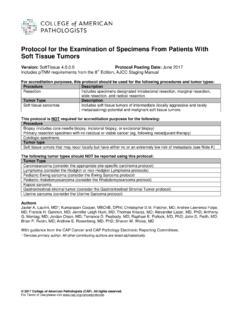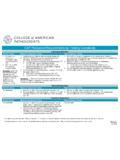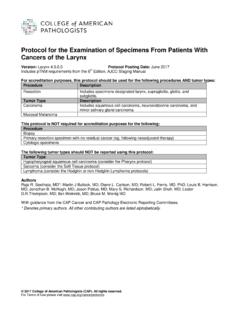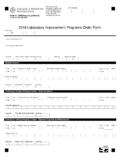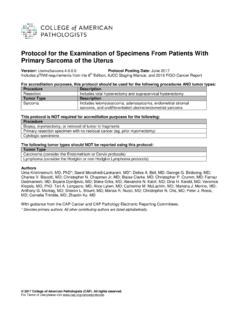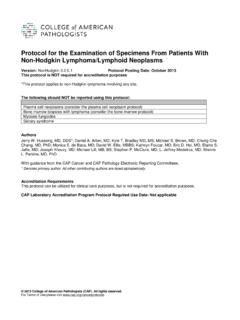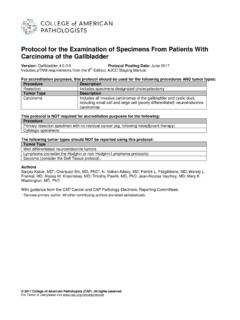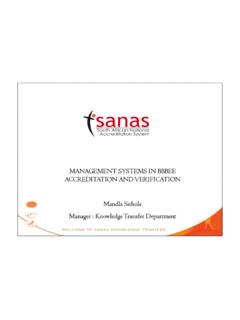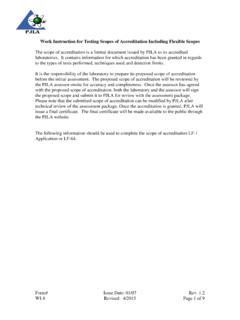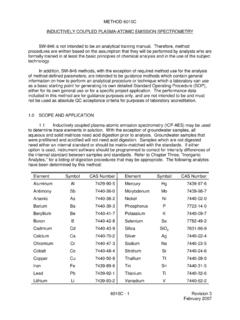Transcription of Protocol for the Examination of Specimens From …
1 Protocol for the Examination of Specimens From patients with hepatocellular carcinoma Version: hepatocellular Protocol Posting Date: June 2017 Includes pTNM requirements from the 8th Edition, AJCC Staging Manual For accreditation purposes, this Protocol should be used for the following procedures AND tumor types: Procedure Description Resection Includes Specimens designated hepatic resection, partial or complete Tumor Type Description carcinoma hepatocellular carcinoma and fibrolamellar carcinoma This Protocol is NOT required for accreditation purposes for the following: Procedure Biopsy Primary resection specimen with no residual cancer (eg, following presurgical therapy) Cytologic Specimens The following tumor types should NOT be reported using this Protocol : Tumor Type Poorly differentiated neuroendocrine carcinoma (consider the Intrahepatic Bile Ducts Protocol ) Well-differentiated neuroendocrine tumor Hepatoblastoma (consider the Hepatoblastoma Protocol ) Lymphoma (consider the Hodgkin or non-Hodgkin Lymphoma protocols) Sarcoma (consider the Soft Tissue Protocol ) Authors Sanjay Kakar, MD*; Chanjuan Shi, MD, PhD*; Patrick L.
2 Fitzgibbons, MD; Wendy L. Frankel, MD; Alyssa M. Krasinskas, MD; Mari Mino-Kenudson, MD; Timothy Pawlik,, MD, MPH, PhD; Jean-Nicolas Vauthey, MD; Mary K. Washington, MD, PhD with guidance from the CAP Cancer and CAP Pathology Electronic Reporting Committees. * Denotes primary author. All other contributing authors are listed alphabetically. 2017 College of American Pathologists (CAP). All rights reserved. For Terms of Use please visit Gastrointestinal hepatocellular carcinoma hepatocellular Accreditation Requirements This Protocol can be utilized for a variety of procedures and tumor types for clinical care purposes. For accreditation purposes, only the definitive primary cancer resection specimen is required to have the core and conditional data elements reported in a synoptic format. Core data elements are required in reports to adequately describe appropriate malignancies. For accreditation purposes, essential data elements must be reported in all instances, even if the response is not applicable or cannot be determined.
3 Conditional data elements are only required to be reported if applicable as delineated in the Protocol . For instance, the total number of lymph nodes examined must be reported, but only if nodes are present in the specimen . Optional data elements are identified with + and although not required for CAP accreditation purposes, may be considered for reporting as determined by local practice standards. The use of this Protocol is not required for recurrent tumors or for metastatic tumors that are resected at a different time than the primary tumor. Use of this Protocol is also not required for pathology reviews performed at a second institution (ie, secondary consultation, second opinion, or review of outside case at second institution). Synoptic Reporting All core and conditionally required data elements outlined on the surgical case summary from this cancer Protocol must be displayed in synoptic report format.
4 Synoptic format is defined as: Data element: followed by its answer (response), outline format without the paired "Data element: Response" format is NOT considered synoptic. The data element must be represented in the report as it is listed in the case summary. The response for any data element may be modified from those listed in the case summary, including Cannot be determined if appropriate. Each diagnostic parameter pair (Data element: Response) is listed on a separate line or in a tabular format to achieve visual separation. The following exceptions are allowed to be listed on one line: o Anatomic site or specimen , laterality, and procedure o Pathologic Stage Classification (pTNM) elements o Negative margins, as long as all negative margins are specifically enumerated where applicable The synoptic portion of the report can appear in the diagnosis section of the pathology report, at the end of the report or in a separate section, but all Data element: Responses must be listed together in one location Organizations and pathologists may choose to list the required elements in any order, use additional methods in order to enhance or achieve visual separation, or add optional items within the synoptic report.
5 The report may have required elements in a summary format elsewhere in the report IN ADDITION TO but not as replacement for the synoptic report all required elements must be in the synoptic portion of the report in the format defined above. CAP Laboratory Accreditation Program Protocol Required Use Date: March 2018* * Beginning January 1, 2018, the 8th edition AJCC Staging Manual should be used for reporting pTNM. CAP hepatocellular Protocol Summary of Changes The following data elements were modified: Pathologic Stage Classification (pTNM, AJCC 8th Edition) Tumor Focality Histologic Type Histologic Grade Tumor Extension Lymph-Vascular Invasion Microscopic Invasion Perineural Invasion Additional Pathological Findings 2 Gastrointestinal hepatocellular carcinoma hepatocellular The following data elements were added: Tumor Characteristics Satellitosis The following data element was deleted: Tumor Size Clinical History 3 CAP Approved Gastrointestinal hepatocellular carcinoma hepatocellular Surgical Pathology Cancer Case Summary Protocol posting date: June 2017 hepatocellular carcinoma : Select a single response unless otherwise indicated.
6 Procedure (select all that apply) (Note A) ___ Wedge resection ___ Partial hepatectomy + ___ Major hepatectomy (3 segments or more) + ___ Minor hepatectomy (less than 3 segments) ___ Total hepatectomy ___ Other (specify): _____ ___ Not specified Tumor Characteristics (Note B) Tumor Focality ___ Solitary ___ Multiple For multiple tumors, repeat the following 4 elements (Tumor Site, Tumor Size, Treatment Effect, and Satellitosis) for up to 5 largest tumor nodules Tumor Site ___ Right lobe ___ Left lobe ___ Caudate lobe ___ Quadrate lobe ___ Segmental location (specify): _____ ___ Other (specify): _____ Tumor Size Greatest dimension of viable tumor (centimeters): ___ cm + Additional dimensions (centimeters): ___ x ___ cm + Greatest dimension of tumor on gross exam (centimeters): ___ cm Treatment Effect ___ No known presurgical therapy ___ Complete necrosis (no viable tumor) ___ Incomplete necrosis (viable tumor present) + Percentage tumor necrosis: ____% ___ No necrosis ___ Cannot be determined (explain): _____ + Satellitosis + ___ Not identified + ___ Present + ___ Cannot be determined Histologic Type (Note C) ___ hepatocellular carcinoma ___ Fibrolamellar carcinoma + Data elements preceded by this symbol are not required for accreditation purposes.
7 These optional elements may be clinically important but are not yet validated or regularly used in patient management. 4 CAP Approved Gastrointestinal hepatocellular carcinoma hepatocellular ___ Other histologic type not listed (specify): _____ ___ carcinoma , type cannot be determined Histologic Grade (Note D) Note: For multiple tumors, select the worst grade. ___ G1: Well differentiated ___ G2: Moderately differentiated ___ G3: Poorly differentiated ___ G4: Undifferentiated ___ Other (specify): _____ ___ GX: Cannot be assessed ___ Not applicable Tumor Extension (select all that apply) ___ No evidence of primary tumor ___ Tumor confined to liver ___ Tumor involves a major branch of the portal vein ___ Tumor involves hepatic vein(s) ___ Tumor involves (perforates) visceral peritoneum ___ Tumor directly invades gallbladder ___ Tumor directly invades diaphragm ___ Tumor directly invades other adjacent organs (specify):_____ ___ Cannot be assessed Margins (Note E) Parenchymal Margin ___ Cannot be assessed ___ Uninvolved by invasive carcinoma Distance of invasive carcinoma from margin (millimeters or centimeters): ___ mm or ___ cm ___ Involved by invasive carcinoma ___ Not applicable Other Margin (required only if applicable) Specify margin.
8 _____ ___ Cannot be assessed ___ Uninvolved by invasive carcinoma ___ Involved by invasive carcinoma Vascular Invasion (Note F) ___ Not identified ___ Present + ___ Small vessel invasion + ___ Large vessel invasion (major branch of hepatic vein or portal vein) + Specify tumor nodule(s) (if applicable): _____ ___ Cannot be determined + Perineural Invasion + ___ Not identified + ___ Present + Specify tumor nodule(s) (if applicable): _____ + ___ Cannot be determined Regional Lymph Nodes ___ No lymph nodes submitted or found + Data elements preceded by this symbol are not required for accreditation purposes. These optional elements may be clinically important but are not yet validated or regularly used in patient management. 5 CAP Approved Gastrointestinal hepatocellular carcinoma hepatocellular Lymph Node Examination (required only if lymph nodes are present in the specimen ) Number of Lymph Nodes Involved: ____ ___ Number cannot be determined (explain): _____ Number of Lymph Nodes Examined: ____ ___ Number cannot be determined (explain): _____ Pathologic Stage Classification (pTNM, AJCC 8th Edition) (Note G) Note: Reporting of pT, pN, and (when applicable) pM categories is based on information available to the pathologist at the time the report is issued.
9 Only the applicable T, N, or M category is required for reporting; their definitions need not be included in the report. The categories ( with modifiers when applicable) can be listed on 1 line or more than 1 line. TNM Descriptors (required only if applicable) (select all that apply) ___ m (multiple primary tumors) ___ r (recurrent) ___ y (posttreatment) Primary Tumor (pT) ___ pTX: Primary tumor cannot be assessed ___ pT0: No evidence of primary tumor ___ pT1: Solitary tumor <2 cm, or >2 cm without vascular invasion ___ pT1a: Solitary tumor 2 cm ___ pT1b: Solitary tumor >2 cm without vascular invasion ___ pT2: Solitary tumor >2 cm with vascular invasion, or multiple tumors, none >5 cm ___ pT3: Multiple tumors, at least one of which is >5 cm ___ pT4: Single tumor or multiple tumors of any size involving a major branch of the portal vein or hepatic vein, or tumor(s) with direct invasion of adjacent organs other than the gallbladder or with perforation of visceral peritoneum Regional Lymph Nodes (pN) ___ pNX: Regional lymph nodes cannot be assessed ___ pN0: No regional lymph node metastasis ___ pN1.
10 Regional lymph node metastasis Distant Metastasis (pM) (required only if confirmed pathologically in this case) ___ pM1: Distant metastasis + Specify site(s), if known: _____ + Additional Pathologic Findings (select all that apply) (Note H) + ___ None identified + ___ Fibrosis (specify extent, providing name of the scheme and assessment scale used): _____ + ___ Cirrhosis + ___ Low-grade dysplastic nodule + ___ High-grade dysplastic nodule + ___ Steatosis + ___ Steatohepatitis + ___ Iron overload + ___ Chronic hepatitis (specify etiology): _____ + ___ Other (specify): _____ + Ancillary Studies + Specify: _____ + Data elements preceded by this symbol are not required for accreditation purposes. These optional elements may be clinically important but are not yet validated or regularly used in patient management. 6 CAP Approved Gastrointestinal hepatocellular carcinoma hepatocellular + Comment(s) + Data elements preceded by this symbol are not required for accreditation purposes.
